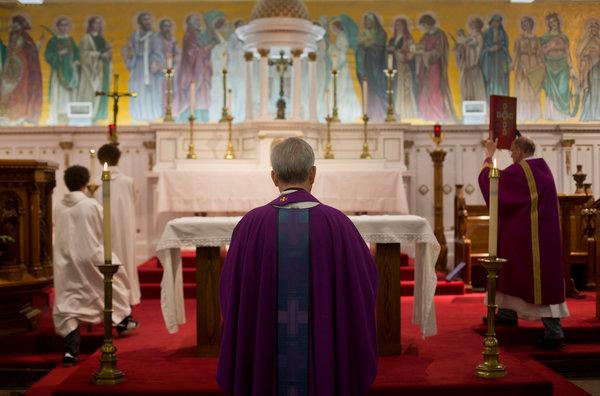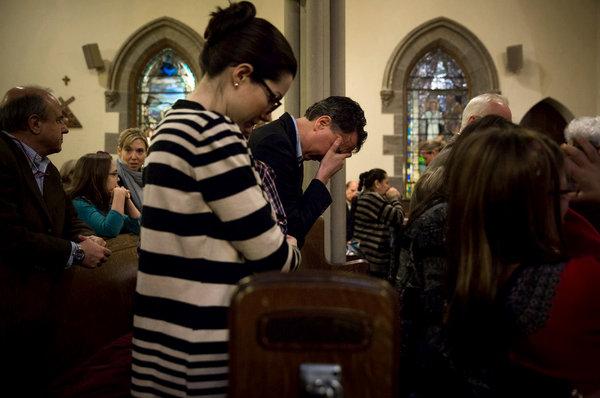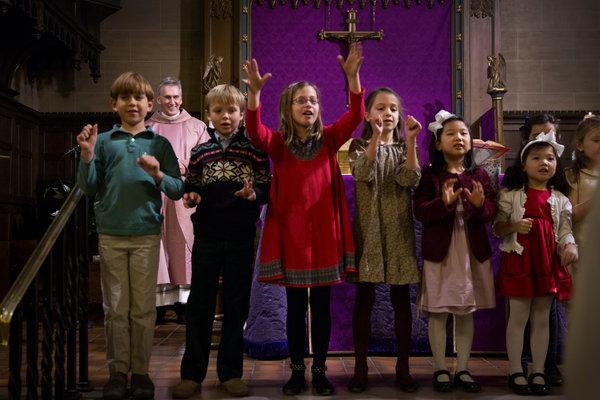|
New York Archdiocese Appears Likely to Shutter More Churches
By Sharon Otterman
The sweeping reorganization of the Roman Catholic Archdiocese of New York, set to take effect next year, is likely to involve the merger or the closing of significantly more parishes than was originally announced last month, archdiocese documents show. Church officials said in November that 112 of the archdiocese’s 368 parishes would be consolidated to create 55 new parishes, the largest realignment of the parish structure in the history of the archdiocese, which stretches from Staten Island to the Catskills. In 31 of those new parishes, one or more of the original churches would no longer be used for regular services, effectively shuttering those churches by August. But the documents show that Cardinal Timothy M. Dolan has now proposed that an additional 38 parishes merge, to create 16 new ones. Among the affected churches, 11 would effectively close, with no regular Masses to be celebrated there. The remaining 27 church buildings would remain open for the celebration of the sacraments after the parishes merge. Cardinal Dolan, the archbishop of New York, hinted last month that a small number of additional parish consolidations might occur, but his new proposals have shocked many parishioners, who received word of them only in the past few weeks. The earlier round of mergers and closings followed more than a year of discussions between parishes and an advisory panel, which was charged with presenting recommendations about parish consolidations to Cardinal Dolan. In the new cases, however, the proposals came directly from Cardinal Dolan and other senior archdiocesan officials, who felt the advisory group had not gone far enough in recommending changes, said Joseph Zwilling, the archdiocese’s spokesman. Rather than making the decisions unilaterally, the cardinal decided to return the new proposals to the parishes for comments before making his final decisions. “It must be noted that these are just proposals,” Mr. Zwilling said. “They are not decisions.” The parishes have until March 1 to respond to the cardinal with their concerns. The additional mergers and closings would most likely take place by Aug. 15, along with the earlier round, if Cardinal Dolan does not reconsider them. The parish reorganization is being driven by a shortage of priests, financial troubles and declining weekly church attendance, which hovers at less than 15 percent of the archdiocese’s Catholics on an average Sunday, according to the archdiocese. But church officials have been reluctant to comment on the reasoning behind specific mergers, which can be especially frustrating to parishes that appear to be flourishing. Among the parishes that are now endangered, for example, is the Church of St. Thomas More on the Upper East Side, which parishioners call vibrant and strong, with about 3,500 members and Sunday services that are filled with young families. The parish covers its costs and has $1.5 million in cash reserves. Its intimate sanctuary was the setting for John F. Kennedy Jr.’s memorial service, because it had been Jacqueline Kennedy Onassis’s parish. The parish has one of the highest per capita donor profiles in the entire archdiocese, Christopher E. Baldwin, a trustee, said. It recently finished an $800,000 round of improvements to the church’s buildings. Its community space hosts a highly regarded nursery school and accommodates some 400 community meetings per year. Shocked by the archdiocese’s recommendation, the church’s pastor, the Rev. Kevin Madigan, told his parishioners in a Nov. 23 letter that he pressed church officials for the reason St. Thomas was being recommended for closing. He was told, he said, that “since St. Thomas More will eventually close some day, it is better to do it now rather than later, when there is presently a momentum within the archdiocese to merge parishes.” The explanation was not satisfying to parishioners, who are now fighting to save the church, which was built as an Episcopal church in 1870 and was intended to resemble a small chapel in the English countryside. Mr. Baldwin warned that the archdiocese would be shortsighted to shutter an institution that generous donors love. “Closing St. Thomas More reminds me of a man who would eat his leg to fill his belly,” he said. “He may be full for a short period of time, but he soon will again be hungry. And God help him when he gets up to walk, let alone run.” The additional churches that are now being proposed for closing are St. John Neumann on Staten Island; St. John the Martyr and St. Gregory the Great in Manhattan; St. Joseph’s, Our Lady of Grace, St. Francis of Assisi and St. Anthony’s in the Bronx; Our Lady of Mount Carmel in White Plains; Our Lady of Pompeii, in Westchester County; and St. Mary’s, in Orange County. At St. Gregory the Great on West 90th Street, parishioners had been confident that the church would remain open after the archdiocese’s advisory panel agreed that it was a vital part of the neighborhood’s Catholic life. Then, in November, they learned that the archdiocese was suggesting that their parish merge with Holy Name of Jesus six blocks north, and that their church be closed for regular use. “It is absolutely at the last minute; it is very, very distressing,” Marie LaMarr, a parishioner since 1970, said. “We are trying to get meetings with the cardinal, and we want to find out what exactly came up in the last two weeks that made him decide on this.” Though their small parish is tucked between two larger ones, parishioners say they relish the intimacy. It serves a diverse mix of Haitians, Latinos and whites, and shares a building with a thriving Catholic school that is to remain open. “It’s a wonderful place, and I’m sorry that it seems to be in danger,” said Msgr. Michael Crimmins, the pastor. Particularly upsetting to parishioners, he added, was that the archdiocese had assured them that the merger decisions would be guided by input from the parishes themselves, which did not appear to have happened in this case. “It almost seems as though because the answer that they gave wasn’t what the archdiocese wanted,” he said, officials “ignored it.”
|
.
Any original material on these pages is copyright © BishopAccountability.org 2004. Reproduce freely with attribution.


